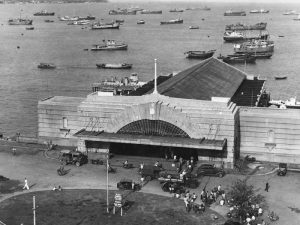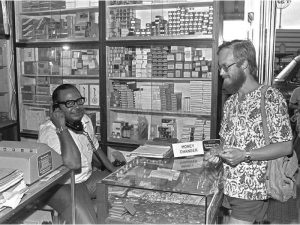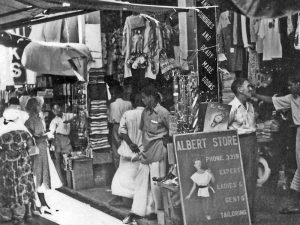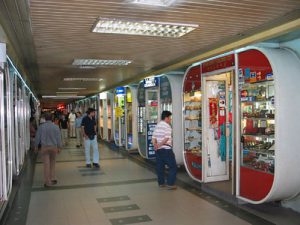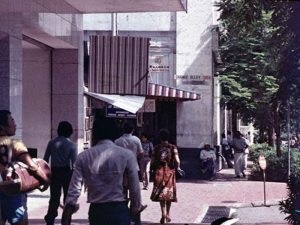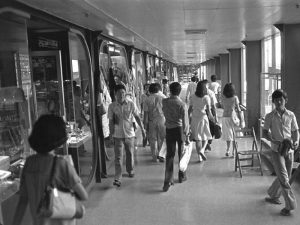History of Change Alley
Change Alley is a lane located in the downtown core of the central region. Stretching from Raffles Place to Collyer Quay, Change Alley was the site of a bazaar that became famed for the diversity of goods available at bargain prices and its numerous money changers. It closed in 1989 and has since reopened at its former site as a multistorey shopping arcade.
History
Change Alley acquired its current name on 11 November 1890 – a decision made by the municipal commissioners, who deliberated between “Change Lane” and “Change Alley”.1 The lane was likely named after the trading hub known as Exchange Alley (also referred to as Change Alley) in London, England,2 as Singapore’s Change Alley was historically a place where locals conducted barter trade with regional sea merchants and Europeans. Some also believe that its name was derived from the large number of Indian money changers there.3
Although Change Alley had yet to become a famous destination in the 1920s, it was already a recognised meeting place for European buyers and Asian brokers. Since there were only a few stalls located in the alley at the time, it served as a convenient thoroughfare for pedestrians to get from Collyer Quay to Raffles Place.4
Description and activities
From the early 1930s, the bazaar in the approximately 100-metre-long Change Alley gained a reputation for its hustle and bustle. Besides the presence of money changers,5 there was also a thriving market where Chinese dealers traded in gambier, pepper, copra, tin and other types of produce, alongside compradors serving the European merchants. Change Alley had become an attraction for tourists who came to Singapore by ship, as well as sailors.6 They arrived at Clifford Pier along Collyer Quay7 and made their way from the seafront to Raffles Place through this narrow alley.8
By the mid-20th century, the goods and services sold in Change Alley had diversified dramatically. These ranged from clothes, briefcases, watches, toys, fishing accessories to handicrafts, souvenirs, tailoring, and shoe polish and cobbler services. Besides small shops and makeshift tables, roving salesmen also made their rounds with a wooden box containing their wares such as pens and watches.9 An improvised awning for the alley was created using zinc, plastic or canvas sheets that sometimes could not prevent leaks on rainy days.10
Bargaining for goods and touting by stallholders were key features of shopping at Change Alley. Although the alley was narrow, congested and stuffy, it is fondly remembered by locals as an atmospheric and unique place in modern Singapore.11
Due to the diverse customer base, some shopkeepers picked up phrases in various languages including French, German, Italian and Russian so as to conduct business with the foreigners.12 The money changers, most of whom were Indians, ran their business within their own shops.13 There were also illegal money changers stationed at both entrances of the alley, touting their currencies at flexible exchange rates.14
In 1973, following a revamp of Clifford Pier, the Change Alley Aerial Plaza, an air-conditioned shopping arcade, opened on the bridge linking the pier to Change Alley.15
Closure and reopening
Business at Change Alley, which sat on prime land, saw a dwindling number of customers in the 1980s. This was attributed to a number of reasons such as the decline in sea travel, competition with modern air-conditioned shopping centres, and the withdrawal of foreign troops from Singapore.16 On 30 April 1989, the shops in Change Alley opened for the last time after a period of bargain sales to clear stocks. Affected stallholders were offered the option of renting sundry and cooked-food stalls at markets and food centres.17
At the Collyer Quay side, the entrance to Change Alley was at the four-storey Winchester House, which had existed since 1905.18 On the other end of the alley at Raffles Place was Shell House, a 14-storey office block completed in 196019 and renamed Singapore Rubber House after it was sold in 1976.20 These two buildings were demolished after Change Alley was cleared out.21 Change Alley returned following the completion of Caltex House (now known as Chevron House) and Hitachi Tower (now 16 Collyer Quay) in 1993 on the sites of Singapore Rubber House and Winchester House respectively22 – albeit as an air-conditioned shopping arcade flanked by the two skyscrapers.23



